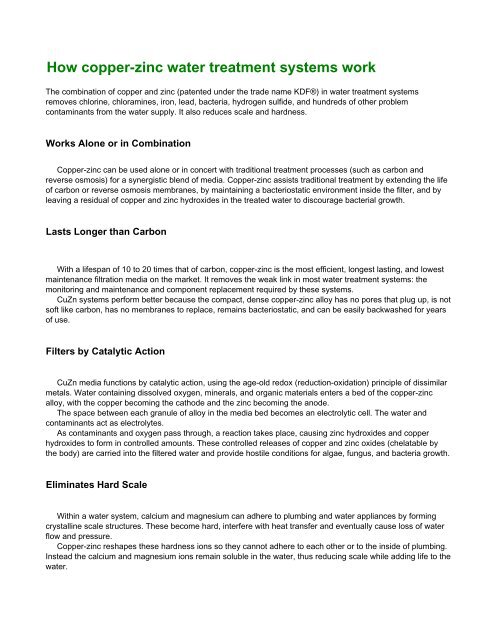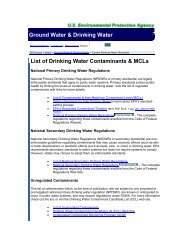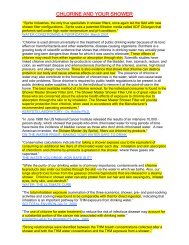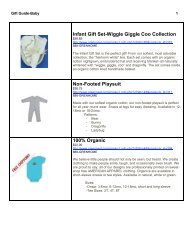(PDF) How copper-zinc water treatment systems work - Green Nest
(PDF) How copper-zinc water treatment systems work - Green Nest
(PDF) How copper-zinc water treatment systems work - Green Nest
Create successful ePaper yourself
Turn your PDF publications into a flip-book with our unique Google optimized e-Paper software.
<strong>How</strong> <strong>copper</strong>-<strong>zinc</strong> <strong>water</strong> <strong>treatment</strong> <strong>systems</strong> <strong>work</strong><br />
The combination of <strong>copper</strong> and <strong>zinc</strong> (patented under the trade name KDF®) in <strong>water</strong> <strong>treatment</strong> <strong>systems</strong><br />
removes chlorine, chloramines, iron, lead, bacteria, hydrogen sulfide, and hundreds of other problem<br />
contaminants from the <strong>water</strong> supply. It also reduces scale and hardness.<br />
Works Alone or in Combination<br />
Copper-<strong>zinc</strong> can be used alone or in concert with traditional <strong>treatment</strong> processes (such as carbon and<br />
reverse osmosis) for a synergistic blend of media. Copper-<strong>zinc</strong> assists traditional <strong>treatment</strong> by extending the life<br />
of carbon or reverse osmosis membranes, by maintaining a bacteriostatic environment inside the filter, and by<br />
leaving a residual of <strong>copper</strong> and <strong>zinc</strong> hydroxides in the treated <strong>water</strong> to discourage bacterial growth.<br />
Lasts Longer than Carbon<br />
With a lifespan of 10 to 20 times that of carbon, <strong>copper</strong>-<strong>zinc</strong> is the most efficient, longest lasting, and lowest<br />
maintenance filtration media on the market. It removes the weak link in most <strong>water</strong> <strong>treatment</strong> <strong>systems</strong>: the<br />
monitoring and maintenance and component replacement required by these <strong>systems</strong>.<br />
CuZn <strong>systems</strong> perform better because the compact, dense <strong>copper</strong>-<strong>zinc</strong> alloy has no pores that plug up, is not<br />
soft like carbon, has no membranes to replace, remains bacteriostatic, and can be easily backwashed for years<br />
of use.<br />
Filters by Catalytic Action<br />
CuZn media functions by catalytic action, using the age-old redox (reduction-oxidation) principle of dissimilar<br />
metals. Water containing dissolved oxygen, minerals, and organic materials enters a bed of the <strong>copper</strong>-<strong>zinc</strong><br />
alloy, with the <strong>copper</strong> becoming the cathode and the <strong>zinc</strong> becoming the anode.<br />
The space between each granule of alloy in the media bed becomes an electrolytic cell. The <strong>water</strong> and<br />
contaminants act as electrolytes.<br />
As contaminants and oxygen pass through, a reaction takes place, causing <strong>zinc</strong> hydroxides and <strong>copper</strong><br />
hydroxides to form in controlled amounts. These controlled releases of <strong>copper</strong> and <strong>zinc</strong> oxides (chelatable by<br />
the body) are carried into the filtered <strong>water</strong> and provide hostile conditions for algae, fungus, and bacteria growth.<br />
Eliminates Hard Scale<br />
Within a <strong>water</strong> system, calcium and magnesium can adhere to plumbing and <strong>water</strong> appliances by forming<br />
crystalline scale structures. These become hard, interfere with heat transfer and eventually cause loss of <strong>water</strong><br />
flow and pressure.<br />
Copper-<strong>zinc</strong> reshapes these hardness ions so they cannot adhere to each other or to the inside of plumbing.<br />
Instead the calcium and magnesium ions remain soluble in the <strong>water</strong>, thus reducing scale while adding life to the<br />
<strong>water</strong>.
(Water without these minerals is flat and can be aggressive, since <strong>water</strong> in its most natural state contains<br />
minerals such as calcium and magnesium, picked up from the earth as it filters through rock strata.)<br />
This scale reduction feature is ideal for cooling towers, hot <strong>water</strong> heaters, <strong>water</strong> lines, plumbing, ice-makers,<br />
fountains, and other <strong>water</strong>-using equipment and appliances.<br />
Removes Hydrogen Sulfide<br />
Hydrogen sulfide is present in many U.S. <strong>water</strong> supplies. Recognized by its rotten egg odor and taste, it is a<br />
poisonous gas that can, in large amounts, cause nausea and illness or death. It is also corrosive to metals,<br />
which is especially serious in older plumbing <strong>systems</strong> that used lead-based solder.<br />
When hydrogen sulfide passes through <strong>copper</strong>-<strong>zinc</strong> media, spontaneous oxidation removes the hydrogen<br />
sulfide by creating <strong>zinc</strong> oxides and <strong>zinc</strong> sulfates. Zinc oxides and <strong>zinc</strong> sulfates are defined as food supplements<br />
and nutrients by the Food and Drug Administration.<br />
(During the <strong>copper</strong>-<strong>zinc</strong> filtration process, minuscule traces of <strong>zinc</strong> and <strong>copper</strong> are released into the <strong>water</strong>. In<br />
proper amounts, both <strong>copper</strong> and <strong>zinc</strong> are necessary for healthy body functions. The trace amounts found in<br />
CuZn filtered <strong>water</strong> are a small percentage of the minimum daily requirement for these minerals.)<br />
Meets NSF, EPA Standards<br />
In 1992, the Environmental Protection Agency ruled that <strong>copper</strong>-<strong>zinc</strong>, patented as KDF-, qualifies as a<br />
mechanical device. This means the media imparts nothing harmful to the <strong>water</strong>. The National Sanitation<br />
Foundation tested KDF® and found it to be in compliance with its Standard 61 for <strong>water</strong> <strong>treatment</strong> plant<br />
applications and Standard 42 for aesthetic effects (taste, odor, chlorine reduction).<br />
Removes Heavy Metals<br />
Copper-<strong>zinc</strong> <strong>systems</strong> are excellent at removing heavy metals, often by electroplating them to the media's<br />
<strong>copper</strong>-<strong>zinc</strong> granules. Under normal circumstances, CuZn filtration removes 90 to 98% of heavy metals,<br />
including lead, iron, arsenic, and cadmium.<br />
Works With Chlorination<br />
When iron, hydrogen sulfide, or bacteria are present in large concentrations, CuZn filtration can be preceded<br />
by chlorination and retention time. Chlorination oxidizes these contaminants and assists the <strong>copper</strong>-<strong>zinc</strong> media<br />
in their removal. The <strong>copper</strong>-<strong>zinc</strong>, of course, then removes the chlorine and remaining contaminants from the<br />
With carbon-only <strong>systems</strong>, this combination of chlorination and filtration is not efficient because the carbon is<br />
quickly depleted when high levels of chlorine pass through it.<br />
Works With Carbon
Many CuZn <strong>systems</strong> use carbon filtration in concert with chlorination and <strong>copper</strong>-<strong>zinc</strong> filtration to treat <strong>water</strong><br />
with high levels of organic contaminants which carbon is excellent at removing.<br />
Because the carbon is not removing chlorine (the <strong>copper</strong>-<strong>zinc</strong> does this before the <strong>water</strong> reaches the carbon)<br />
and because the <strong>copper</strong>-<strong>zinc</strong> provides a bacteriostatic environment, carbon's life is greatly increased. (Bacterial<br />
fouling of the carbon media is a serious problem in carbon-only <strong>water</strong> filtration and requires frequent media





